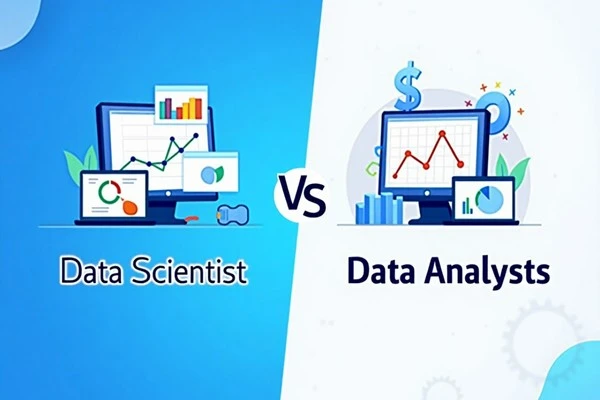Data Scientist vs Data Analyst: In today’s data-driven world, the roles of data scientists and data analysts are often intertwined, yet distinct. Both professions are crucial in helping organizations make informed decisions through data. However, data scientists and analysts differ significantly in their skills, tools, and job responsibilities. If you’re considering a career in data but unsure whether to become a data scientist or a data analyst, this article will guide you through the key differences, provide insights into the career paths, and help you choose the best role based on your skills and interests.
What is a Data Scientist?
A highly specialized data scientist combines advanced analytics, machine learning, and statistical modeling to interpret complex data and create predictive models. Data scientists work with large, often unstructured datasets to make data-driven predictions and optimize business operations.
Key Responsibilities of a Data Scientist:
-
Predictive Modeling
-
Example: Using historical customer data, a data scientist might build a model to predict customer churn or project sales for the next quarter.
-
-
Machine Learning and AI
-
Example: Implementing a neural network to optimize user recommendations on an e-commerce platform.
-
-
-
Machine learning algorithms are used to make predictions and automate data analysis.
-
-
Big Data Processing
-
Data scientists often use big data tools like Hadoop and Spark to process massive datasets that can’t be handled with traditional databases. Big data refers to large, complex datasets that are difficult to manage with standard data processing tools.
-
-
Data Wrangling
-
Cleaning and preparing data for analysis by handling missing values, removing duplicates, and transforming raw data into usable formats.
-
-
Advanced Data Visualization
-
Example: Using tools like Tableau or Matplotlib to create visualizations that make predictive models more accessible for non-technical stakeholders.
-
Skills Required for Data Scientists:
-
Python and R: Extensive use of libraries like Pandas and NumPy for data manipulation.
-
Machine Learning: Algorithms like regression, classification, and neural networks.
-
Big Data Technologies: Knowledge of Hadoop, Spark, and distributed systems.
-
Statistical Analysis: Strong understanding of statistics to build models and interpret data patterns.
-
Cloud Computing: Tools such as AWS or Google Cloud to manage and scale data processing.
What is a Data Analyst?
A data analyst interprets structured data, generates reports, and creates dashboards that help businesses make data-driven decisions. Unlike data scientists, data analysts primarily work with preexisting datasets and use descriptive analytics to identify trends, patterns, and insights.
Key Responsibilities of a Data Analyst:
-
Data Collection and Cleaning:
-
Example: Writing SQL queries to pull data from a customer database, followed by data cleaning to eliminate errors and inconsistencies.
-
-
Exploratory Data Analysis (EDA):
-
Example: Analyzing sales data to identify seasonality or trends in customer purchases.
-
-
Reporting and Visualization:
-
Example: Using Tableau to build dashboards that track sales performance or customer satisfaction.
-
-
SQL Queries:
-
Example: Writing complex queries to retrieve data from databases or combining data from different sources to form comprehensive reports.
-
-
Business Intelligence:
-
Example: Helping marketing teams by analyzing customer behavior data to optimize ad targeting.
-
Skills Required for Data Analysts:
-
SQL: Essential for querying and extracting data from relational databases.
-
Excel: Ability to handle large datasets, use pivot tables, and perform fundamental analysis.
-
Data Visualization: Using tools like Tableau and Power BI to create clear and actionable visual reports.
-
Basic Statistics: Knowledge of basic statistical methods to analyze trends and detect patterns.
-
Business Acumen: Understanding of how data fits within the context of business operations.
Key Differences Between Data Scientists and Data Analysts
The core difference between data scientists and analysts lies in their job focus, tools, and skills. Here’s a detailed comparison
| actor | Data Scientist | Data Analyst |
|---|---|---|
| Primary Focus | Build predictive models and machine learning algorithms to automate and analyze data. | Analyze past data to provide insights for business decisions. |
| Tools Used | Python, R, TensorFlow, Hadoop, Spark | SQL, Excel, Tableau, Power BI |
| Work Complexity | Work with big data, complex models, and machine learning algorithms. | Work with structured data and create actionable reports and visualizations. |
| Salary Range | $100,000 – $130,000 (U.S.) | $60,000 – $80,000 (U.S.) |
| Educational Requirements | Master’s or PhD in technology (e.g., Computer Science, Statistics) | Bachelor’s degree in business or related fields |
| Job Outcome | Predictive insights, machine learning models, and automated processes. | Reports, dashboards, business insights. |
| Role Example | Building a model to predict customer churn or demand forecasting. | Analyzing sales data to identify top-performing regions. |
Which Role Should You Pursue? Data Scientist or Data Analyst?
If You Should Pursue a Data Scientist Role:
-
You have a strong machine learning, AI, and predictive analytics background.
-
You enjoy programming and working with advanced statistical models.
-
You’re interested in working with big data and using tools like Hadoop or Spark.
-
You aim to solve complex business problems by developing predictive models and automating data analysis.
If You Should Pursue a Data Analyst Role:
-
You prefer working with structured data and generating reports that help businesses understand past performance.
-
You enjoy data visualization and presenting findings to non-technical stakeholders.
-
You have strong skills in SQL and Excel, and tools like Tableau for data reporting and business intelligence.
-
You want to focus on providing actionable insights for business strategy and decision-making.
Career Growth and Salary Expectations
Both roles offer lucrative careers, but data scientists generally earn more due to their specialized skills in machine learning, AI, and big data technologies. Here are the average salaries for both roles in the U.S.:
-
Data Scientist Salary:
On average, a data scientist earns $100,000 – $130,000 annually, with senior-level positions reaching higher salaries.
-
Data Analyst Salary:
The average salary for a data analyst ranges from $60,000 to $80,000 annually, but it can increase with specialization and experience.
Career Growth:
-
Data Scientist:
Progression can lead to Machine Learning Engineer, AI Specialist, or Chief Data Officer roles.
-
Data Analyst:
Can advance to positions like Business Intelligence Analyst, Data Visualization Expert, or Data Engineer.
Educational Paths: How to Enter These Roles?
Data Scientist:
-
Traditional Path:
Most data scientists have master’s degrees or PhDs in Science, Mathematics, or Statistics. They often have a deep understanding of machine learning and big data technologies.
-
Alternative Pathways:
Bootcamps like Data Science Bootcamp or online courses from Coursera, edX, or Udacity offer flexible learning paths to enter the field.
Data Analyst:
-
Traditional Path: A bachelor’s degree in Business Analytics, Mathematics, or a related field is common. You can also gain skills through certifications in SQL, Tableau, or Power BI.
-
Alternative Pathways: Online certification programs like those offered by Google Data Analytics or DataCamp can help you break into the field.
FAQs:
Q1. What is the primary difference between a data scientist and a data analyst?
A data scientist builds predictive models and uses machine learning to solve complex business problems, while a data analyst focuses on data interpretation and generating reports based on historical data.
Q2. Can a data analyst become a data scientist?
A data analyst can transition into a data scientist by learning machine learning, programming, and big data technologies. Many boot camps and online certifications can assist with this transition.
Q3. Which tools are most commonly used by data analysts?
Data analysts typically use SQL, Excel, Tableau, and Power BI to query databases, analyze data, and create reports and dashboards.
Q4. How long does it take to become a data scientist?
Becoming a data scientist typically requires 3-5 years of formal education, such as a master’s or PhD in a technical field, or completing a boot camp combined with hands-on experience.
Q5. Is it possible to become a data analyst without a degree?
Many data analysts have successfully entered the field by completing online certifications or bootcamps in SQL, Tableau, or Google Data Analytics.
Call to Action:
Are you ready to pursue a career in data science or data analysis? Leave a comment below to share your thoughts or experiences, or check out our other resources to help you start your data career journey!










